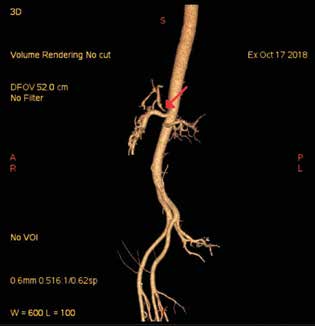Abstract
Introduction: Arterial aneurysms of the pancreaticoduodenal arcade (PDA) represent approximately 2% of all aneurysms of visceral arteries. Despite a low incidence, this group of aneurysms is clinically significant due to its high risk of rupture.
Case report: A 45 years old patient presented with a pancreaticoduodenal arcade aneurysm rupture along with a tight stenosis at the origin of the coeliac trunk. Retrograde blood flow from the superior mesenteric artery (SMA) to the hepatic artery (HA) via PDA limited our therapeutic options due to the necessity to maintain liver perfusion. The patient was indicated for an interventional radiology procedure, which consisted of percutaneous transluminal angioplasty (PTA) with stent placement at the origin of the coeliac trunk and subsequent transarterial embolisation (TAE) – trapping of the aneurysm using coils. Due to clinical signs of the intra-abdominal compartment syndrome, within 24 hours of the radiological treatment, the patient was indicated for surgical revision (laparotomy). During the surgery, no signs of active bleeding were found; coagula were evacuated from the abdominal cavity (800 ml) and laparostomy was performed with a temporary closure using a grid. Final closure of the abdominal cavity was performed on postoperative day 20 from the initial procedure. Follow-up abdominal CT performed 22 months after TAE showed no recurrence of the aneurysm.
Conclusion: Aneurysm rupture represents a serious case of acute abdomen which requires urgent treatment. The preferred method of treatment for ruptured PDA aneurysms is the endovascular intervention using TAE, which is associated with lower morbidity and mortality...

